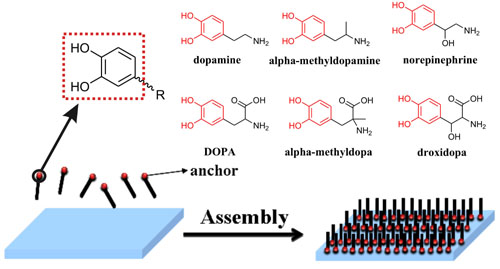
Schematic representation of the self–assembly of catecholic derivatives on the surface of substrates (Image by ZHOU Feng et al.)
The research group headed by Prof. ZHOU Feng and Prof. LIU Weimin at the Lanzhou Institute of Chemical Physics (LICP) of the CAS has published a critical review on the self-assembly of catechol derivatives in Chemical Society Reviews (Bioinspired catecholic chemistry for surface modification. Qian Ye, Feng Zhou, Weimin Liu, Chem. Soc. Rev., 2011, DOI: 10.1039/c1cs15026j) at the invitation of the journal. The latest impact factor of the journal is 20.086.
In recent years, the surface self-assembly of dopamine and their derivatives have attracted considerable attention. Papers and patents concerning them have multiplied. The present paper, for the first time, describes the state-of-the-art research on the surface self-assembly of catechol and their derivatives, namely the design and synthesis of catecholic molecules, their adsorption mechanisms and the stability of assemblies in solution, and their applications etc. Catechols and their derived compounds can self-assemble on various inorganic and organic materials, including noble metals, metals, metal oxides, mica, silica, ceramics and even polymers. It has opened a new route to the modification of various substrates and the preparation of functional composite materials.
Dopamine exists abundantly in organism. Dopamine-modified substrates show excellent bio-compatibility, Moreover, many anti-fouling dopamine derivatives have appeared, which makes the research on dopamine derivatives an important area in biomaterials. The catecholic derivatives self-assembled substrates exhibit excellent stability to water and have a good adhesion. Researchers are increasingly interested in the application of these compounds in ships and other marine operation. The review serves as a reference for those engaging in this area.
The surface/interface research group and polymer tribology research group of the State Key Laboratory of Solid Lubrication at LICP have carried out a systematic research on the area and achieved a series of results.
Firstly, researchers have synthesized various catecholic derivatives and studied the self-assembly process of monolayered catecholic derivatives. Based on these they have grafted polymers with different functions on various substrates. It is found that catecholic anchor showed good adhesion to substrates and the composite materials exhibited good stability. In addition, by controlling the polymerization condition, researchers have obtained polydopamine thin films and investigated their zwitterionicity. They have synthesized Pdop capsules by the spontaneous oxidative polymerization of dopamine and deposition on the template surface, and subsequent removal of the template and found that the capsules exhibited outstanding unidirectional loading to Rh6G in some solvents.
Secondly, with polydopamine as the design platform, they have assembled a series of polydopamine-based multilayered composite thin films on surfaces of various materials. The relationship between the micro-structure and various properties of the films (tribological, anti-corrosive properties and bio-compability) has been investigated. The results show that the introduction of polydopamine enhanced the stability of composite thin films. The films showed excellent tribological, anti-corrosive properties and biocompatibility.
The above work has been published in Chem. Commun. (2010, 46, 5900), J. Mater. Chem. (2010, 20, 6910), Macromolecules ( 2010,43, 5554), Carbon (2010, 48, 2347), Phys. Chem. Chem. Phys. (2010, 12, 5480), Electrochim. Acta ( 2010, 55, 2004), J. Colloid Interface Sci. (2010, 351, 261), Chem. Commun. (2009, 45, 6789), J. Phys. Chem. C (2009, 113, 7677), J. Phys. Chem. C (2009, 113, 20429), Appl. Surf. Sci. (2009, 256, 894), Colloids and Surfaces B: Biointerfaces (2010, 76, 123), Progress in Organic Coatings (2010, 68, 244) and Surface and Interface Analysis (2010, 22, 803).
The work has received support from the National Natural Science Foundation of China .


